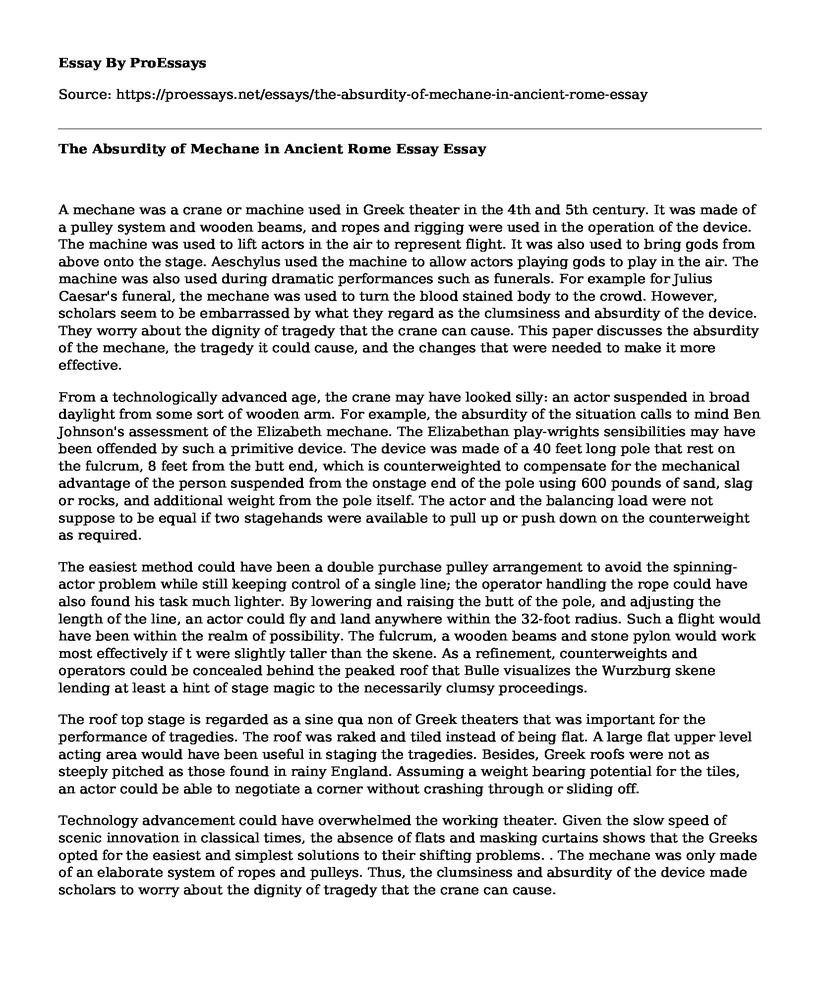A mechane was a crane or machine used in Greek theater in the 4th and 5th century. It was made of a pulley system and wooden beams, and ropes and rigging were used in the operation of the device. The machine was used to lift actors in the air to represent flight. It was also used to bring gods from above onto the stage. Aeschylus used the machine to allow actors playing gods to play in the air. The machine was also used during dramatic performances such as funerals. For example for Julius Caesar's funeral, the mechane was used to turn the blood stained body to the crowd. However, scholars seem to be embarrassed by what they regard as the clumsiness and absurdity of the device. They worry about the dignity of tragedy that the crane can cause. This paper discusses the absurdity of the mechane, the tragedy it could cause, and the changes that were needed to make it more effective.
From a technologically advanced age, the crane may have looked silly: an actor suspended in broad daylight from some sort of wooden arm. For example, the absurdity of the situation calls to mind Ben Johnson's assessment of the Elizabeth mechane. The Elizabethan play-wrights sensibilities may have been offended by such a primitive device. The device was made of a 40 feet long pole that rest on the fulcrum, 8 feet from the butt end, which is counterweighted to compensate for the mechanical advantage of the person suspended from the onstage end of the pole using 600 pounds of sand, slag or rocks, and additional weight from the pole itself. The actor and the balancing load were not suppose to be equal if two stagehands were available to pull up or push down on the counterweight as required.
The easiest method could have been a double purchase pulley arrangement to avoid the spinning-actor problem while still keeping control of a single line; the operator handling the rope could have also found his task much lighter. By lowering and raising the butt of the pole, and adjusting the length of the line, an actor could fly and land anywhere within the 32-foot radius. Such a flight would have been within the realm of possibility. The fulcrum, a wooden beams and stone pylon would work most effectively if t were slightly taller than the skene. As a refinement, counterweights and operators could be concealed behind the peaked roof that Bulle visualizes the Wurzburg skene lending at least a hint of stage magic to the necessarily clumsy proceedings.
The roof top stage is regarded as a sine qua non of Greek theaters that was important for the performance of tragedies. The roof was raked and tiled instead of being flat. A large flat upper level acting area would have been useful in staging the tragedies. Besides, Greek roofs were not as steeply pitched as those found in rainy England. Assuming a weight bearing potential for the tiles, an actor could be able to negotiate a corner without crashing through or sliding off.
Technology advancement could have overwhelmed the working theater. Given the slow speed of scenic innovation in classical times, the absence of flats and masking curtains shows that the Greeks opted for the easiest and simplest solutions to their shifting problems. . The mechane was only made of an elaborate system of ropes and pulleys. Thus, the clumsiness and absurdity of the device made scholars to worry about the dignity of tragedy that the crane can cause.
Cite this page
The Absurdity of Mechane in Ancient Rome Essay. (2022, Apr 18). Retrieved from https://proessays.net/essays/the-absurdity-of-mechane-in-ancient-rome-essay
If you are the original author of this essay and no longer wish to have it published on the ProEssays website, please click below to request its removal:
- Veterans Reactions to Their Experiences of the First World War and Homecoming
- Roman Pragmatism Essay Example
- Rapid Urban Growth During the Gilded Age Essay Example
- Essay Example on Hugh Williamson: Founding Father of the USA
- Paper Example on US History: From Chaos to Union - A Progressive Journey
- Essay Example on the Aftermath of War: Understanding International Conflict Expansion
- Essay Sample on Race & Social Construct: W.E.B. Dubois' Color Line, Veil Theories







